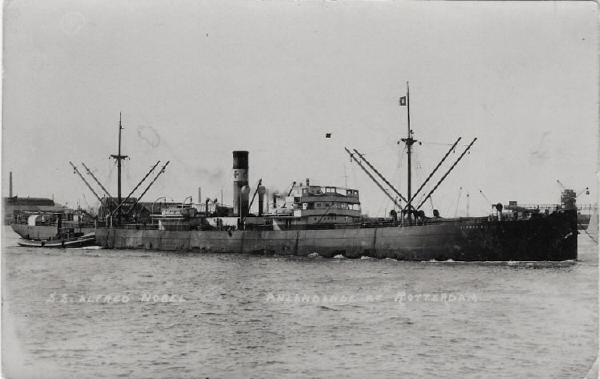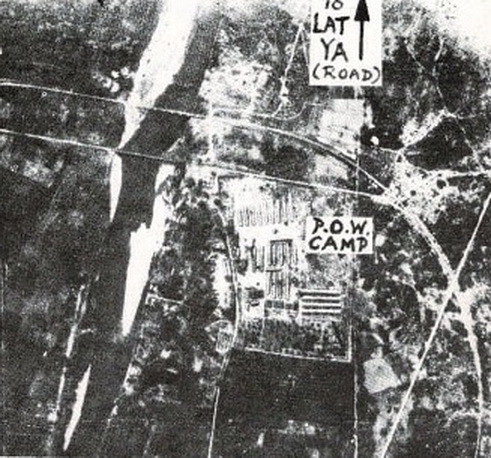Part 1 Bombed at sea
While en route from Singapore to Rangoon, the US and Dutch POWs were part of a three-ship convoy. The convoy came under a bombing attack by US B-24s, probably flying out of India or Ceylon. One of the transports (Nichimei Maru) carrying many Dutch Prisoners and the accompanying gunboat were sunk (no Americans were on that transport). The ship carrying the US POWs (Moji Maru) was hit in the stern and damaged but continued on to Burma. By the time they approached the port, the ship was listing badly so the guards herded the prisoners to one side of the ship in an effort to correct the list.

A number of POWs have described the ‘near miss’ that took place in JAN 43 as the main US group was sailing from Singapore to Burma. They were in a three ship convoy consisting of a small gunboat (apparently a converted civilian vessel) and two Hellships: the Nichimei Maru and Moji Maru.
About a day’s sailing out of Moulmein, they were spotted by a flight of three US B-24s. Each plane in turn banked over and made a bombing run. The first hit the gunboat which disintegrated on impact. The stick of bombs from the second fell directly into the forward hold of the Nichimei Maru. The ship broke in half and the forward section sank quickly. This had been occupied by IJA Railway Engineers and is thought to have contained a looted Steam Engine from Malaya. The aft section was occupied by Dutch POWs. Most of them were able to get into the water, some with life jackets.
The Moji Maru was carrying the Tharp group of US and other Australian POWs. The bombs from the third plane straddled the ship showering it with shrapnel. A few of the AUS POWs were killed and others severely wounded, but the ship was not heavily damaged. Drawn by the commotion of the first two attacks, the POWs stood on the deck watching in horror as that third plane made its bomb run.
They go on to describe something of a comedy of errors that likely saved their lives. The Moji Maru had two field artillery pieces chained to the deck; one forward and one aft. The B-24 must have approached bow to stern. The Japanese fired the forward cannon as the plane approached then swung it around for a second shot. This one hit the ship’s bridge starting a fire. When the aft cannon was fired at the departing plane, it exploded killed the crew and igniting a second fire.
Apparently out of bombs and low on fuel, the planes turned for home. The sight of the burning ship convinced them that they had hit it. The POWs assisted the crew in extinguishing the fires and the captain halted the ship to pick up survivors.
It may be mostly legend or wishful thinking, but the story is told that the Dutch POWs drowned any of the Japanese that they encountered in the water. In some versions, it was the US POWs doing the drowning, but there would not have been any US personnel in the water! Dozens of Dutch were brought aboard the Moji, including a cat mascot. Japanese records state that only about 100 of the 1500 personnel aboard were lost, but do not relate how they were rescued.
The medical staff were quite busy tending the wounded. One Australian is described as having a severe head wound that exposed part of his brain but he was walking around seemingly un-phased by that wound; until he died! US MAJ Rogers stated in a post-war correspondence that LTC Tharp received a head wound from shrapnel that bothered him for the rest of his life. His wound was serious enough that he was hospitalized upon arrival at Moulmein and joined the rest of the men some weeks later.
The deck was crowded with the newly added Dutch and bomb damage had caused the ship to list. The POWs were said to have been herded to one side to help correct that list! The ship limped into Moulmein the next day and the AUS POWs were buried there. Others were sent to the town hospital.
[See the account in Section 3.4.6 of USAF COL Sledge contacting the men that he nearly killed.]
In his North Texas Univ Oral History interview (OH-486), Army medic Ray Reed makes the interesting statement that in the confusion of the aftermath of the bombing a few of the sailors were discussing trying to seize the ship and sail west towards India. Of course, they had no idea if there was sufficient fuel for such a journey. This ‘plan’ was scuttled when a Dutch officer told the ship’s captain who immediately armed his crew.
Two members of the HMAS PERTH crew were KIA in this incident; see Section 27
Per the http://www.combinedfleet.com/Nichimei_t.htm website:
9 January 1943:
NICHIMEI MARU departs Singapore for Rangoon, Burma in convoy S-23 also consisting of MOJI MARU escorted by subchaser CH-8 and and auxiliary net layer CHOKO MARU. NICHIMEI MARU is carrying 1,562 IJA troops and 965 Dutch POWs. MOJI MARU is carrying an unknown number of IJA troops and 450 American and 385 Australian POWs.
15 January 1943:
Gulf of Martaban. 50 miles from Moulmein. At about 1520, a flight of USAAF Tenth Air Force Consolidated B-24 “Liberator” heavy bombers attacks the convoy. On their first pass, their bombs straddle NICHIMEI MARU and cut communications. On their next pass, one bomb hits between her No. 2 hold and the engine room, another bomb hits the bridge, and others are near misses. NICHIMEI MARU comes to a stop and takes on a 15 degree list. The bombers return and strafe the convoy. The B-24s next target MOJI MARU and damage her with near-miss bombs. About 12 Australian POWs, including two sailors from cruiser HMAS PERTH, are KIA. At 1550, NICHIMEI MARU sinks at 13-30N, 97-30E. 97 IJN soldiers including engineers bound for the Burma Railway and five gunners and crewmen are KIA. 38 Dutch POWs are also killed. The ship also takes down a locomotive, RR ties and hundreds of picks and shovels intended for the Burma Railway.
[See the bio of AAF COL Sledge in Section 3.6.4]
Part 2 Bombed on land
In his account of his time on the TBR, Army 1LT Fillmore gives a vivid account of the bombing raids that Allied bombers made on the two bridges at Kanchanaburi (which he denotes as Kanburi). His is the first account that I have seen that described that indeed both bridges were destroyed but that the original wooden bridge was quickly repaired. According to his story, the railroad operated more or less at full capacity carrying supplies to Burma and evacuating wounded from Oct ’43 until Jan ’45 when the number of bridges destroyed by bombing was beyond the capacity to repair. The bombing was so inaccurate that bombs frequently fell on the POW camp near the bridges. Luckily there were few casualties (no US POWs were killed) but the threat was such that some were moved across the river to the ChungKai hospital camp for safety.

Part 3 1 KIA
The single US POW on the TBR who did not die of disease or malnutrition was CPL Edwin WILSON. He was KIA on 12 JUN 43 when an Allied bomber hit the Thanbuzayat hospital camp when he had been sent from the Tharp Party.
